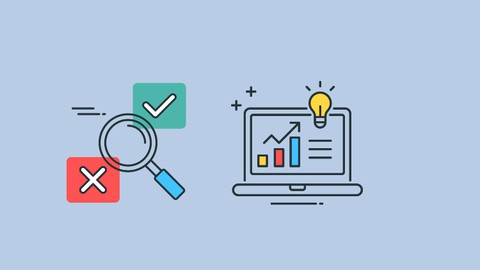
Data Exploration & Visualization with databases and Power BI
Data Exploration & Visualization with databases and Power BI, available at $39.99, has an average rating of 4.33, with 13 lectures, based on 9 reviews, and has 1335 subscribers.
You will learn about Install SQL Server Load sample database into SQL Server Install PostgreSQL Load sample database into PostgreSQL Connect Power BI to SQL Server Connect Power BI to PostgreSQL Explore SQL Server Database and create visualizations in Power BI Explore PostgreSQL Database and create visualizations in Power BI This course is ideal for individuals who are Beginner Data Analyst or Beginner Data Scientist It is particularly useful for Beginner Data Analyst or Beginner Data Scientist.
Enroll now: Data Exploration & Visualization with databases and Power BI
Summary
Title: Data Exploration & Visualization with databases and Power BI
Price: $39.99
Average Rating: 4.33
Number of Lectures: 13
Number of Published Lectures: 13
Number of Curriculum Items: 13
Number of Published Curriculum Objects: 13
Original Price: $24.99
Quality Status: approved
Status: Live
What You Will Learn
- Install SQL Server
- Load sample database into SQL Server
- Install PostgreSQL
- Load sample database into PostgreSQL
- Connect Power BI to SQL Server
- Connect Power BI to PostgreSQL
- Explore SQL Server Database and create visualizations in Power BI
- Explore PostgreSQL Database and create visualizations in Power BI
Who Should Attend
- Beginner Data Analyst
- Beginner Data Scientist
Target Audiences
- Beginner Data Analyst
- Beginner Data Scientist
Data exploration is the initial step in data analysis, where users explore a large data set in an unstructured way to uncover initial patterns, characteristics, and points of interest. This process isn’t meant to reveal every bit of information a dataset holds, but rather to help create a broad picture of important trends and major points to study in greater detail. Data exploration can use a combination of manual methods and automated tools such as data visualizations, charts, and initial reports.
Exploratory Data Analysis (EDA) is the first step in your data analysis process. Here, you make sense of the data you have and then figure out what questions you want to ask and how to frame them, as well as how best to manipulate your available data sources to get the answers you need. You do this by taking a broad look at patterns, trends, outliers, unexpected results and so on in your existing data, using visual and quantitative methods to get a sense of the story this tells. You’re looking for clues that suggest your logical next steps, questions or areas of research.
Data analysis is a process of inspecting, cleansing, transforming, and modelling data with the goal of discovering useful information, informing conclusions, and supporting decision-making.
Data visualization is the presentation of data in a pictorial or graphical format. It enables decision makers to see analytics presented visually, so they can grasp difficult concepts or identify new patterns.
We will connect to Microsoft SQL Server and PostgreSQL as our data sources then explore the database data before creating visualizations.
Course Curriculum
Chapter 1: Data Exploration and Visualization
Lecture 1: Introduction
Lecture 2: Installing Power BI Desktop
Lecture 3: Download SQL Server
Lecture 4: Install SQL Server
Lecture 5: Install SSMS
Lecture 6: Connect SSMS to SQL Server
Lecture 7: Install Sample Database
Lecture 8: Power BI & SQL Server Data Exploration & Visualization
Lecture 9: Install PostgreSQL
Lecture 10: Connecting to PostgreSQL Database Server
Lecture 11: Download and load sample database
Lecture 12: Power BI & PostgreSQL Server Data Exploration & Visualization- Part 1
Lecture 13: Power BI & PostgreSQL Server Data Exploration & Visualization- Part 2
Instructors
-
Bluelime Learning Solutions
Making Learning Simple
Rating Distribution
- 1 stars: 0 votes
- 2 stars: 1 votes
- 3 stars: 1 votes
- 4 stars: 3 votes
- 5 stars: 4 votes
Frequently Asked Questions
How long do I have access to the course materials?
You can view and review the lecture materials indefinitely, like an on-demand channel.
Can I take my courses with me wherever I go?
Definitely! If you have an internet connection, courses on Udemy are available on any device at any time. If you don’t have an internet connection, some instructors also let their students download course lectures. That’s up to the instructor though, so make sure you get on their good side!
You may also like
- Top 10 Video Editing Courses to Learn in November 2024
- Top 10 Music Production Courses to Learn in November 2024
- Top 10 Animation Courses to Learn in November 2024
- Top 10 Digital Illustration Courses to Learn in November 2024
- Top 10 Renewable Energy Courses to Learn in November 2024
- Top 10 Sustainable Living Courses to Learn in November 2024
- Top 10 Ethical AI Courses to Learn in November 2024
- Top 10 Cybersecurity Fundamentals Courses to Learn in November 2024
- Top 10 Smart Home Technology Courses to Learn in November 2024
- Top 10 Holistic Health Courses to Learn in November 2024
- Top 10 Nutrition And Diet Planning Courses to Learn in November 2024
- Top 10 Yoga Instruction Courses to Learn in November 2024
- Top 10 Stress Management Courses to Learn in November 2024
- Top 10 Mindfulness Meditation Courses to Learn in November 2024
- Top 10 Life Coaching Courses to Learn in November 2024
- Top 10 Career Development Courses to Learn in November 2024
- Top 10 Relationship Building Courses to Learn in November 2024
- Top 10 Parenting Skills Courses to Learn in November 2024
- Top 10 Home Improvement Courses to Learn in November 2024
- Top 10 Gardening Courses to Learn in November 2024






















